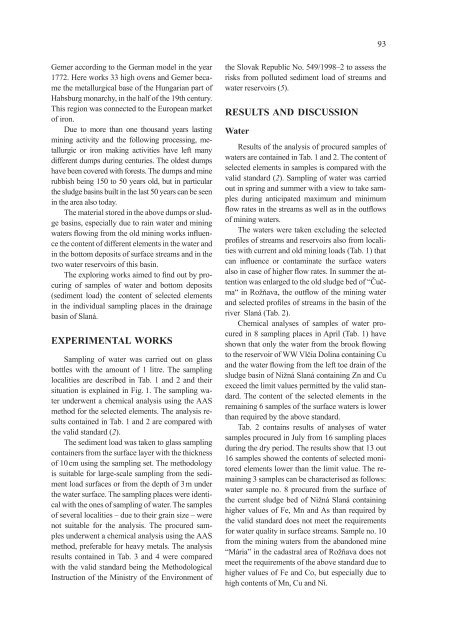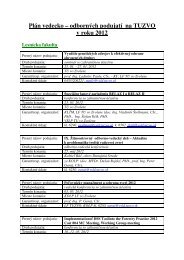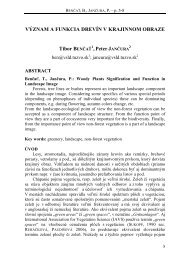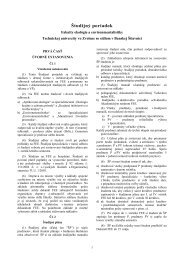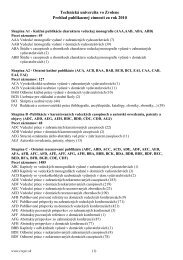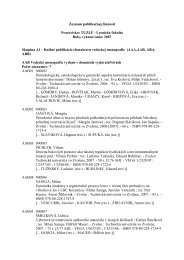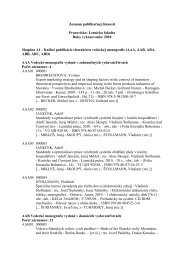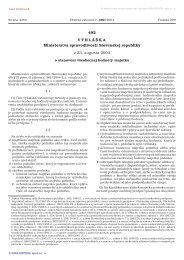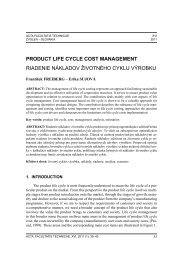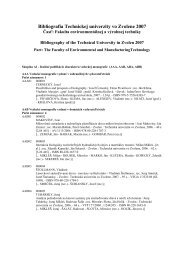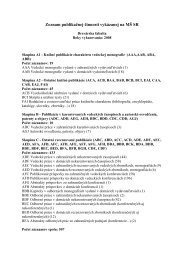Acta Facultatis Ecologiae - Technická univerzita vo Zvolene
Acta Facultatis Ecologiae - Technická univerzita vo Zvolene
Acta Facultatis Ecologiae - Technická univerzita vo Zvolene
- No tags were found...
Create successful ePaper yourself
Turn your PDF publications into a flip-book with our unique Google optimized e-Paper software.
93Gemer according to the German model in the year1772. Here works 33 high ovens and Gemer becamethe metallurgical base of the Hungarian part ofHabsburg monarchy, in the half of the 19th century.This region was connected to the European marketof iron.Due to more than one thousand years lastingmining activity and the following processing, metallurgicor iron making activities have left manydifferent dumps during centuries. The oldest dumpshave been covered with forests. The dumps and minerubbish being 150 to 50 years old, but in particularthe sludge basins built in the last 50 years can be seenin the area also today.The material stored in the above dumps or sludgebasins, especially due to rain water and miningwaters flowing from the old mining works influencethe content of different elements in the water andin the bottom deposits of surface streams and in thetwo water reser<strong>vo</strong>irs of this basin.The exploring works aimed to find out by procuringof samples of water and bottom deposits(sediment load) the content of selected elementsin the individual sampling places in the drainagebasin of Slaná.EXPERIMENTAL WORKSSampling of water was carried out on glassbottles with the amount of 1 litre. The samplinglocalities are described in Tab. 1 and 2 and theirsituation is explained in Fig. 1. The sampling waterunderwent a chemical analysis using the AASmethod for the selected elements. The analysis resultscontained in Tab. 1 and 2 are compared withthe valid standard (2).The sediment load was taken to glass samplingcontainers from the surface layer with the thicknessof 10 cm using the sampling set. The methodologyis suitable for large-scale sampling from the sedimentload surfaces or from the depth of 3 m underthe water surface. The sampling places were identicalwith the ones of sampling of water. The samplesof several localities – due to their grain size – werenot suitable for the analysis. The procured samplesunderwent a chemical analysis using the AASmethod, preferable for heavy metals. The analysisresults contained in Tab. 3 and 4 were comparedwith the valid standard being the MethodologicalInstruction of the Ministry of the Environment ofthe Slovak Republic No. 549/1998–2 to assess therisks from polluted sediment load of streams andwater reser<strong>vo</strong>irs (5).RESULTS AND DISCUSSIONWaterResults of the analysis of procured samples ofwaters are contained in Tab. 1 and 2. The content ofselected elements in samples is compared with thevalid standard (2). Sampling of water was carriedout in spring and summer with a view to take samplesduring anticipated maximum and minimumflow rates in the streams as well as in the outflowsof mining waters.The waters were taken excluding the selectedprofiles of streams and reser<strong>vo</strong>irs also from localitieswith current and old mining loads (Tab. 1) thatcan influence or contaminate the surface watersalso in case of higher flow rates. In summer the attentionwas enlarged to the old sludge bed of “Čučma“in Rožňava, the outflow of the mining waterand selected profiles of streams in the basin of theriver Slaná (Tab. 2).Chemical analyses of samples of water procuredin 8 sampling places in April (Tab. 1) haveshown that only the water from the brook flowingto the reser<strong>vo</strong>ir of WW Vlčia Dolina containing Cuand the water flowing from the left toe drain of thesludge basin of Nižná Slaná containing Zn and Cuexceed the limit values permitted by the valid standard.The content of the selected elements in theremaining 6 samples of the surface waters is lowerthan required by the above standard.Tab. 2 contains results of analyses of watersamples procured in July from 16 sampling placesduring the dry period. The results show that 13 out16 samples showed the contents of selected monitoredelements lower than the limit value. The remaining3 samples can be characterised as follows:water sample no. 8 procured from the surface ofthe current sludge bed of Nižná Slaná containinghigher values of Fe, Mn and As than required bythe valid standard does not meet the requirementsfor water quality in surface streams. Sample no. 10from the mining waters from the abandoned mine“Mária” in the cadastral area of Rožňava does notmeet the requirements of the above standard due tohigher values of Fe and Co, but especially due tohigh contents of Mn, Cu and Ni.


